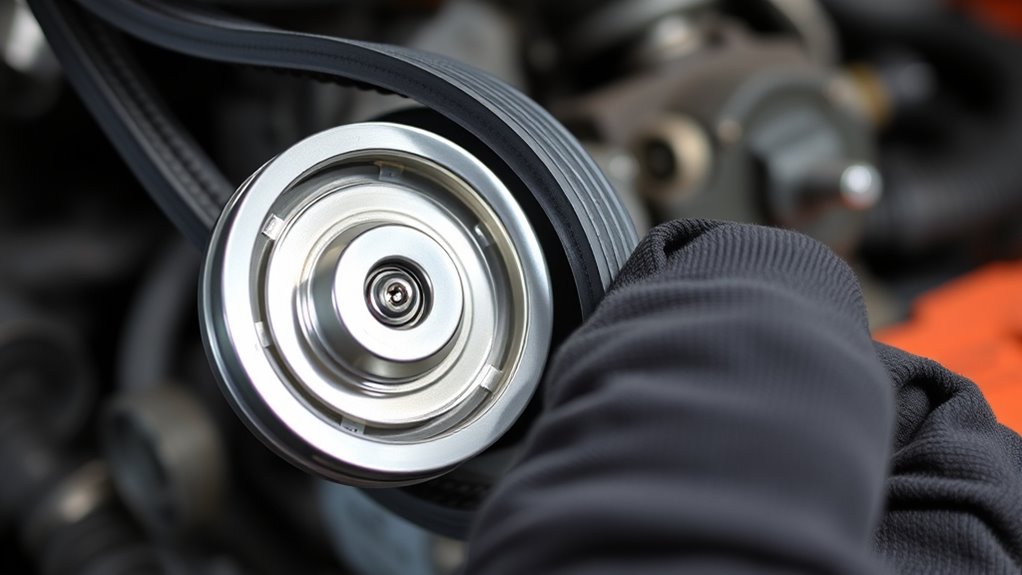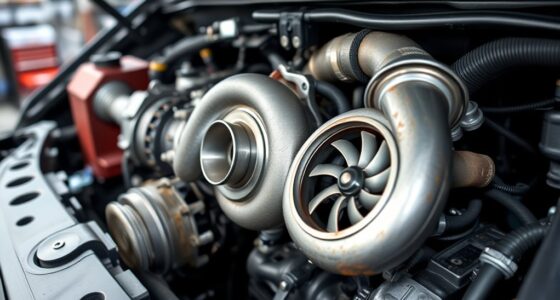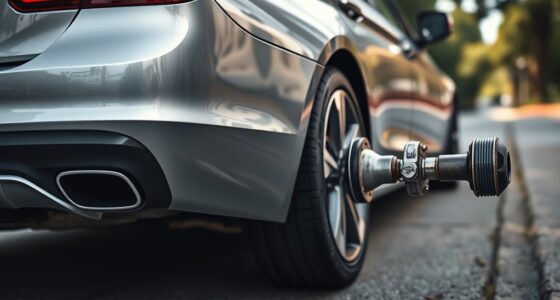If your belts squeal or chirp, start by checking the tensioner to make certain it’s applying proper pressure—apply gentle force and see if it moves too much. Next, inspect the pulleys, spinning each by hand to find any wobbling, roughness, or noise. Look for signs of wear or damage on the belt and pulleys. Keeping an eye on these components helps prevent future issues and keeps your engine running smoothly—learn more to keep your system in top shape.
Key Takeaways
- Inspect the tensioner for proper tension; a firm, minimally wobbly tensioner indicates it’s functioning correctly.
- Check each pulley by spinning them by hand; look for wobbling, roughness, or resistance indicating wear.
- Listen for squealing sounds while the engine runs; noises often point to loose or slipping belts or worn pulleys.
- Examine the belt for cracks, glazing, or fraying, which can cause slipping and noise.
- Regularly maintain and replace worn belts, tensioners, and pulleys to prevent future squeals or chirping sounds.

If your vehicle’s belts are squealing or chirping, it’s a sign that something isn’t quite right. These noises usually point to issues with belt tension or the components that guide and support the belt system. Ignoring these sounds can lead to more serious problems, like belt failure or damage to your engine accessories.
To keep everything running smoothly, it’s essential to check the tensioner and pulleys regularly. These parts maintain proper belt tension and alignment, making sure your belts operate quietly and efficiently.
Start by inspecting the tensioner, which is designed to keep the belt tight. If the tensioner is worn or failing, it won’t apply enough pressure, causing the belt to slip or squeal. You can test the tensioner by applying gentle pressure to the belt with a pry bar or your fingers. It should feel firm and have minimal play. If it moves freely or feels loose, it’s time to replace it.
A faulty tensioner not only causes noise but also increases the risk of belt slippage, which can lead to loss of power steering, alternator charging issues, or overheating.
Next, check the pulleys that guide and support the belt. These include the idler pulley, tensioner pulley, and any other accessory pulleys. Spin each pulley by hand—if you notice roughness, wobbling, or resistance, they might be damaged or worn out.
A pulley that doesn’t spin smoothly can cause the belt to slip or squeal. Sometimes, dirt or debris can get caught in the pulley bearings, causing noise. Clearing out debris or lubricating the bearings (if applicable) can sometimes resolve minor issues, but more often, a pulley replacement is needed.
Look for any signs of wear or damage on the pulleys and belts. Cracks, glazing, or fraying on the belt indicate it’s time for a new one. If the pulleys have visible damage or corrosion, replacing them ensures your belt system remains reliable.
Proper tension and alignment are key; if the belt looks loose or misaligned, double-check that the pulleys are correctly positioned and that the tensioner is functioning properly.
Regularly inspecting these components helps prevent unexpected breakdowns and keeps your engine running quietly. A properly functioning belt system not only reduces noise but also prolongs the lifespan of your engine accessories. If you find yourself unsure about the condition of your tensioner or pulleys, don’t hesitate to consult a professional.
Addressing squealing or chirping belts early on saves you from costly repairs down the road and keeps your vehicle operating smoothly and quietly.
Frequently Asked Questions
How Often Should I Inspect My Belt Tensioner and Pulley?
You should inspect your belt tensioner and pulley every 10,000 to 15,000 miles or at least once a year. Regular checks help catch wear or damage early, preventing breakdowns.
Look for signs like cracks, excessive wear, or noise. If you notice anything unusual, replace or service them promptly.
Keeping these components in good condition guarantees your engine runs smoothly and avoids costly repairs down the line.
Can Belt Noise Indicate a Failing Water Pump?
About 60% of vehicle breakdowns involve cooling system issues, so belt noise might hint at a failing water pump.
If you hear squealing or grinding, don’t ignore it—these sounds can signal a worn water pump bearing or loose belt.
You should check your water pump if the noise persists while the engine runs, especially during temperature changes.
Prompt inspection can prevent costly repairs and overheating risks.
Are There Specific Tools Needed for Tensioner Adjustment?
You’ll need a wrench or socket set to adjust the tensioner. Many tensioners have a specific bolt or nut that you turn to increase or decrease tension.
Some vehicles also require a serpentine belt tool, which is a specialized wrench designed for easier access.
Make sure to check your vehicle’s manual for the exact tools and procedures, as they can vary depending on the make and model.
How Long Do Belts Typically Last Before Squealing?
Belts usually last between 60,000 and 100,000 miles before squealing or showing signs of wear. However, this can vary depending on driving conditions, belt quality, and maintenance.
You should regularly inspect your belts for cracks, fraying, or glazing, and listen for squealing noises.
Replacing worn belts promptly helps prevent breakdowns and keeps your engine running smoothly. Don’t ignore signs of wear or noise, as they indicate it’s time for a new belt.
What Are the Signs of a Pulley Bearing Failure?
When a pulley bearing starts to fail, it’s a sign that trouble’s brewing. You’ll notice a grinding or rumbling noise coming from the pulley area, especially when the engine runs.
You might also see wobbling or misalignment of the pulley, or experience a squeal that doesn’t go away.
If you ignore these signs, the bearing could seize, leading to more expensive repairs down the road.
Conclusion
If your belts start squealing or chirping, it’s a gentle nudge from your vehicle’s heart, hinting that a little attention now can prevent bigger issues later. Don’t ignore these subtle signs; instead, see them as whispers guiding you toward proper care. Checking your tensioner and pulleys isn’t just maintenance—it’s a way to keep your journey smooth and your ride reliable. Embrace these signals, and your car will thank you with many more miles of silent, steady service.









